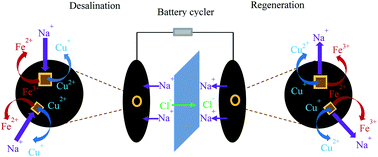A core–shell heterostructured CuFe@NiFe Prussian blue analogue as a novel electrode material for high-capacity and stable capacitive deionization†
Abstract
Prussian blue analogues (PBAs) have recently been proposed as electrode materials for efficient capacitive deionization (CDI). However, there is a conflict between the desalination capacity and stability for single-component bimetallic PBAs, making it difficult to simultaneously achieve high desalination capacity and recyclability. To overcome this limitation, this study made an attempt to synthesize the core@shell heterostructured CuFe@NiFe PBA by enclosing a high-capacity CuFe PBA with the stable NiFe PBA shell. The desalination tests showed that the CuFe@NiFe PBA had a higher desalination capacity with less energy consumption compared with the sole core material, associated with the more rapid intercalation reactions of Na ions due to the unique core–shell heterostructure. Furthermore, the recyclability of the CuFe@NiFe PBA was improved significantly, attributed to the protective effect of the NiFe PBA against the irreversible structural change of the CuFe PBA during the long-term operation. The electrochemical and material measurements revealed that the desalination and regeneration processes were governed by the redox of the Fe3+/Fe2+ couple and Cu2+/Cu+ couple while the Ni3+/Ni2+ couple was electrochemically inactive for the CuFe@NiFe PBA. Consequently, the core–shell heterostructured CuFe@NiFe PBA would be a promising material for application in a CDI system.



 Please wait while we load your content...
Please wait while we load your content...